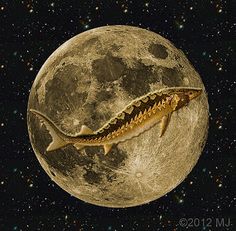We watched the sturgeon moon rise last evening, heralding the harvest season, so the indigenous people of the Great Lakes region would say. Actually, according to the Old Farmer’s Almanac, it won’t reach its fullness until 8:02 a.m. EST on Sunday, Aug. 22. The Algonquin tribe named this full moon after the sturgeon. August is the best time of the year to fish for sturgeon in Lake Champlain, home of the Algonquin, but also elsewhere in the Great Lakes.
The sturgeon moon is a highlight in seasonal transition that brings us to autumn, “a moment to let go and enter the new,” according to blogger Antonio G. Traverso. The sturgeon moon also coincides with the festival of green corn, which occurs in late summer and links to the maturation of the corn crop. This occurrence also serves as a religious ceremony, practiced mainly by indigenous people in the eastern forests and the Southeast: Creek, Cherokee, Seminole, Yuchi, and Iroquois. Corn is not eaten until the Great Spirit has been thanked. Tribal members also give thanks for the wheat, rain, sun, and good harvest.
The sturgeon moon is a ritual of letting go, according to Traverso. It’s akin to similar therapeutic exercises in Western culture. An exercise he describes begins by taking two pieces of paper. During the day, on the first page, write everything consistent with “I am releasing all emotions and regrets from my Body, Mind, and Soul.” On the second page write, “Today I’m creating my future.” Everything you want to do, realize, create, manifest, and be. Eventually, you go to an open place and burn the page of disappointments, allowing the smoke to symbolize “everything that is listed to the Great Spirit or God or Creator as liberation.” You also burn the second page, Turing the ashes into the ground — Mother Earth — with the intention of “planting seeds for tomorrow and every day after.”
Prayer, the word, is related to the word for sturgeon in the Potawatomi language, “Nama.” Sydney Martin, of Bradley, Michigan, tells the story of the sturgeon as a sacred animal, “the one who intercedes for us to the creator, specifically on the weather, making it storm or rain or snow.” As Martin tells it, the Potawatomi were exiled from Michigan during the 19th century “Trail of Tears” saga. When federal officials came to Michigan to remove tribal members from the state’s southwest region, they hid in the woods along the Kalamazoo River. “When the sturgeon would come through there once a year, the Anishinabek (Potawatomi, Ojibwa, Oshawa tribes) would take those; we could dry that and we would have enough food to last our families a year.” Martin extends the significance of the sturgeon as a source of nourishment for the Potawatomi hiding in the woods to the present day, surviving the 2011 Enbridge 6B pipeline break, which released an estimated 1.1 million gallons of diluted bitumen or tar-sands crude-oil into the Kalamazoo River, upstream from the sturgeon spawning grounds. Sturgeon, of course, is an endangered species. “the sturgeon is protecting the sacred river for us — not just Indians but for the whole earth. They probably are doing things that none of us know anything about. They probably are cleaning the river.”
Next month, on Sept. 19, folks in the Milwaukee region of Wisconsin will celebrate “Return of the Sturgeon” as part of “Harbor Fest.” There will be a blessing of the sturgeon and a sturgeon release ceremony.
Post written by Dennis Archambault
